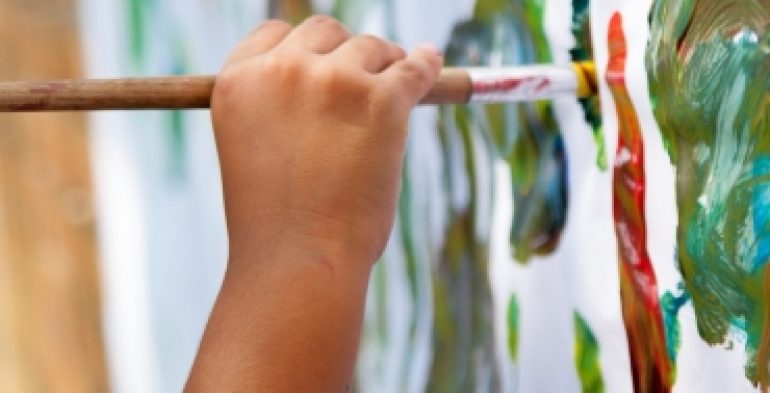
Teachers may plan a painting experience to fill part of the schedule, but what most educators discover is that painting becomes much more than just a simple activity. Painting is a way for children to do many important things: convey ideas, express emotion, use their senses, explore color, explore process and outcomes, and create aesthetically pleasing works and experiences.
Are they too young?
Even very young children can dip their fingers in a paint mix and spread it on a table or tray. Children form many connections and ideas of how the painting process works for them, as well as what they enjoy about it. Watch a child painting and you will see a fully engaged child. We can almost see children’s thoughts, such as, “When I push my brush flat, my line gets bigger”, or “I like stirring this, but I don’t want to put it on paper or touch it”, or “I mixed red with more red and orange, and got fire color red!”
While we listen and observe, we may begin to understand the way a child perceives his world, his developmental abilities, and his needs or interests.
Offer valuable painting experiences
The soothing process of painting is often what is interesting to young children. The pleasant feeling of painting over and over, possibly using two brushes or their fingers, is what is important. As children develop, they become more focused on creating representations and conveying ideas.
Young children need large pieces of paper to have full range of motion as well as a variety of brush sizes to experiment with. Consider offering smaller quantities of paint so children can manage fewer spills and can mix colors without ruining large containers of paint. Color mixing provides endless discoveries.
Painting areas should support the child’s physical abilities. Easels should be at correct height or sturdy platforms added to adjust height. Move chairs from tables to allow children to stand and paint if they wish. Very young children can be held in a lap or sit on the floor with an adult.
Rich conversations
Responding to and encouraging children’s painting is important. See if the invitation is open for conversation first. A good way to start may be to describe what you see; “Your painting has long blue lines and orange circles”. Wait to see if the child responds; she may want to share more with you or just want to return to her painting. Interrupting may interfere with the painting process.
When children seem ready to share, think of thought provoking questions. “I see you used red and yellow. What other colors might you use and where are you going to put them?” or “This part of your paper is filled with pink and white spots. What do you want to do to your painting next?” or, “What are you going to do with your painting when it’s done?”
TDCC – The Developing Child Center – Dubai









